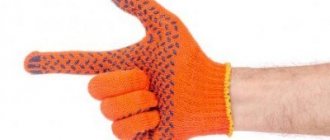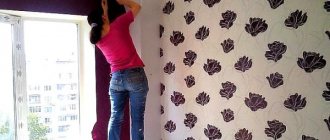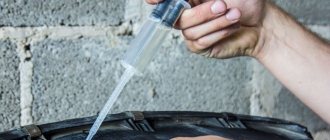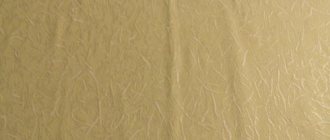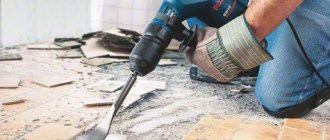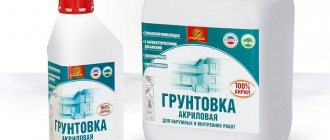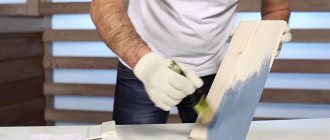Universal methods for removing wallpaper
Dry removal method
Equipment: spatula, scraper, knife.
Procedure: pull the corner and the sheet of paper will come off on its own. Do not make sudden jerks, as the old paper will crumble. If you feel that in some places the paper is attached to the wall tightly enough and cannot be removed, use either a spatula or another method of removal (for example, wet).
The method is ideal for cases when the canvases hardly stick to the wall.
Wet removal method
Equipment: rag, container with water, knife (or other sharp object), spatula.
Procedure: moisten a cloth generously with water and wipe the trellis
It is necessary to pay attention to the optimal intensity of wetting. If you pour a lot of water, it will flow down the wall, and the whole procedure will lose its meaning.
If it’s not enough, the wallpaper won’t get wet. To wet, you need to take a small surface (1 strip is enough, otherwise the paper will have time to dry) and wait for half an hour. It will be good if you make cuts on the wallpaper strips - blotting will be of high quality. Any available means will do. After which the paper is removed with a spatula. In this case, the problem of how to remove old wallpaper will not arise.
Traditionally used for all types. Water allows you to do the job cleanly. There will be less dust than with the dry method.
Special removal products
Equipment: rag (roller, brush), container with water, coating remover (for example, Neomid, Metylan), gloves (in case of using toxic household chemicals).
Procedure: Apply the solution to the wall. After the time has passed, remove the fallen wallpaper.
The products are sold in different forms: powder, gel, liquid. In any case, they are diluted in water in the proportions indicated on the package. These products are economical. One bottle is enough for 70 - 100 sq. meters. The disadvantage of this method is the duration of the procedure. After treatment you will have to wait from 1 to 3 hours. But the wallpaper will come away from the walls on its own.
Of all the industrial products, “Mole” stands out - a liquid for cleaning pipes. If you apply liquid to the canvas using a roller, after a few minutes it will fall off. The downside of "Mole" is toxicity. You need to wear gloves when handling the wall. Then carefully remove any remaining liquid so as not to get a chemical burn.
This option is universal. This is especially convenient for removing thick wallpaper, on which ordinary water has little effect.
Steam method
Equipment: iron (steam generator, steamer), container with water (if using an iron), piece of cloth, spatula, knife.
Procedure: moisten the fabric in water, apply it to the wallpaper and iron it with the hottest possible iron. After this procedure, the old trellises and glue will become soft and can be easily removed with a knife or spatula. If the house has a more modern device - a steam generator, then it will take several minutes before the wallpaper peels off the wall. After all, steam is more effective than water. The main condition is to keep the steam generator at a distance of 5 - 10 cm from the wall. In this case, a rag will no longer be needed. The method is easy to use.
The options listed are suitable for all types of coatings. But they will be more effective when working with paper. Other types of wall coverings have their own specifics.
How to remove wallpaper
To remove old paintings from the walls, you need to do some preparatory work and stock up on the necessary tools. There are several methods for removing trellises, so you can choose the most convenient option in each specific case. Most often, non-professionals choose the steaming method.
It’s great if the old labels from the rolls have been preserved - they must indicate the type of dismantling. Before you begin removing the coating, be sure to find out how it was applied. If it was wallpaper adhesive applied to ground walls, then the task of dismantling is relatively simple. Problems usually appear if the previous material was glued in a non-standard way. It is more difficult if PVA glue was used or the surface was unsuitable. Vinyl wallpaper is the hardest to remove, as it does not absorb moisture.
What's the easiest way to remove it?
The removal method depends on the class of washable wallpaper. The general material and base of the finishing coating affect the complexity of the process.
- Washable with moisture-resistant coating. Decorative finishing copes well with the assigned tasks: moisture does not get between the wall and the trellises, condensation, dust, fungus, and mold do not accumulate. It is difficult to remove this layer, but proper preliminary preparation will give results. It is recommended to treat the canvas with a special compound. Then remove them and sand the wall with sandpaper or a grinding stone.
- Liquid, washable glass wallpaper. Liquid wallpaper is easily removed after softening with water, but with the second category you will have to suffer. Use only special formulations that allow you to get rid of the old in a few hours. Some people who are new to the job are advised to call a professional who knows how to remove fiberglass materials.
- Double layer. Dismantling is carried out layer by layer: first the top, then the bottom. Here are some recommendations:
- the top layer can be removed using technology for moisture-resistant trellises;
- Moisten the bottom layer thoroughly; it will easily come off;
- if the base is made of fabric, then after dismantling it, treat the wall surface with a grinding wheel or any other tool.
Types of washable wallpaper
Washable wallpaper differs in the material from which it is made and the method of processing the front side. Each type has its own performance characteristics that must be taken into account when choosing.
| Name | Compound | Subspecies | Life time | Peculiarities |
| Acrylic wallpaper | Foamed acrylic applied to a paper base | Foam wallpaper | 5-6 years | Acrylic is applied pointwise, which allows the material to “breathe”. Wallpaper cannot be cleaned with a brush. |
| Vinyl wallpapers | Base - paper or fabric, top layer - PVC | Foamed Vinyl, Flat Vinyl, Embossed Vinyl | Up to 20 years | Resistant to fading and fungus. Suitable for painting (up to 15 times) and frequent washing. Suitable for kitchens and bathrooms. |
| Glass wallpaper | Fiberglass (quartz sand, lime, dolomite, soda) | Single-layer and double-layer (paper-based) | More than 20 years | Environmental friendliness, high wear resistance, the possibility of repeated repainting, resistance to aggressive environments. |
| Metallized wallpaper | Multilayer option: porous paper, aluminum foil, non-permeable paint, decorative coating | Hand painted | More than 20 years | High cost, vapor-tight material. Wallpaper is easy to scratch. When gluing, you need to turn off the power. Electrical wiring lines should not run along wallpaper. |
| Wax coated stopper | Cork oak bark, wax impregnation | Various decor options | Up to 20 years | Requires a perfectly flat surface. Antistatic, environmentally friendly. Can be cleaned with a vacuum cleaner. |
We do not give the approximate cost of the listed types of wallpaper, since price categories vary greatly among different manufacturers. If we are not talking about luxury options, then in almost every type you can find wallpaper that is affordable for your budget.
Washable wallpaper can also include various rolled synthetic materials (for example, self-adhesive films on paper or fabric basis). Films can be stylized to resemble leather (devinon), imitate a relief pattern (isoprene, foam film) or coated with a thin layer of plastic (intended for further coloring).
Preparation
In order to effectively cope with this task, you need to prepare the room. The floor must be covered with polyethylene and secured with tape. All paintings and other objects should be removed from the walls. Move the furniture to another room.
Removal with a steamer
Sometimes wallpaper can be removed quite easily - just pull the canvas and it will immediately peel off from the wall. Sometimes you have to wet the wall with water, keep them in this state for 15-20 minutes and then remove the canvas with a spatula. If there is strong glue under the trellises, you will have to use a special tool - a steamer, which will help solve the problem quickly and easily.
Advice. To save money, we recommend using not a steamer, but a household steam cleaner or a simple iron with a steam generator.
A steamer costs a lot in a store; buying it for one-time use is a big waste. Purchasing this tool makes rational sense only in one case - if you are going to make professional money from repairs. The steamer method is ideal for ordinary paper sheets, but in the case of washable wallpaper it is not the best.
How to glue washable wallpaper
As a rule, washable wallpaper is heavier than “land” options. That is why it is worth paying special attention to the selection of glue:
- Vinyl wallpaper requires special glue (for example, “SuperVinyl”). It glides well, making it easier to fit joints.
- Acrylic and glass wallpaper require the use of acrylic adhesive (eg VGT). It is applied only to the wall; there is no need to smear the canvas itself.
- Metallized wallpaper is glued with dispersion glue with a fungicide. They conduct current well, so safety precautions must be observed.
Important! The most common misconception among buyers: the denser the wallpaper, the better it hides wall unevenness. This is not entirely true. The relief and “ductility” of the canvas is responsible for masking defects. The cork will show even the smallest differences in the plaster - the wallpaper's seams simply won't meet. Vinyl and acrylic are more effective in this regard, especially if you choose wallpaper with a suitable pattern.
Radical method of removal
If you need to tear off material from the walls or ceiling that is glued very tightly, for example, preserved from Soviet times, you may encounter serious difficulties. Previously, during repairs, carpenter's glue, bustilate, and PVA were used, which are capable of gluing wallpaper to the wall for centuries and are completely resistant to ordinary soaking.
A drill with a brush attachment will help, with which the coating can simply be mechanically removed from the wall. This method has a drawback: a stiff brush will remove not only wallpaper from the walls, but also a layer of putty, and possibly pieces of plaster.
Method five: special tools
If several layers of paper have accumulated on your walls or a two-layer wallpaper covering (duplex) was pasted during a previous renovation, removing the wallpaper will be very problematic. Too old wallpaper glue, PVA or bustilate can complicate the process even more. This mixture is quite difficult to dissolve and you will probably have to scrape everything off by hand.
For these works you will need a roller with needles or a more gentle means - wallpaper tiger. You need to go over the entire surface with the tool to make holes, moisten the wallpaper with hot water: in this case, the liquid penetrates faster under the paper. We tear off pieces of old canvas with a sharp spatula or scraper, but you need to be careful: the sharp edges of the tool easily leave grooves and dents on the wall, and then you will have to further level it.
If liquid and perforating tools are powerless against the wall covering, you can use a more serious technique: a drill with an attachment for removing wallpaper (round brush) or a sander with a coarse-grained brush. Such work is very dusty, and the wall can be significantly damaged - leveling the surface with putty is inevitable.
You can clean the walls from the old coating using a drill with a special attachment.
Tips from the experts
There are times when there are no special “magic” liquids in the house, and the materials are already ready for removal. Interesting methods will help here:
- Previously glued canvases with PVA glue can be easily removed with a solution prepared from water and dishwashing detergent. There should be a lot of the last ingredient: for example, in 1 liter of water it is enough to stir 3 tbsp. spoons of washing liquid.
- Clean plasterboard walls carefully. This building material, as practice shows, is easily deformed under the influence of water and spatulas. Wallpaper must be wetted and removed gradually: first one canvas, then another.
- The grinder can be replaced with an interesting device - an electric drill with a stiff wire brush attached to it.
- Old glue will soften under the influence of a regular steam iron. But perform manipulations through foil or a damp cloth.
- After treating the surface with hard or abrasive tools, check it for chips and scratches. If damage is noticed, level it with primer or cement mortar.
- To avoid the appearance of yellow spots on freshly glued strips, it is recommended to check the acid-base balance of the surface layer of the wall before applying again. Litmus paper will help you complete the process: if it changes color, then the wall needs to be treated. The deep-penetrating primer Glutogrund LF has proven itself well.
- Vinyls are separated into solid sheets under the influence of a steam generator. The material can be reused for decoration or decoration.


